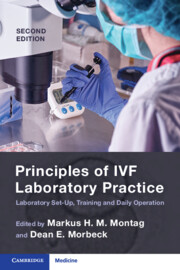Book contents
- Principles of IVF Laboratory Practice
- Principles of IVF Laboratory Practice
- Copyright page
- Contents
- Contributors
- Foreword
- The Evolution of IVF Practice
- Section 1 Starting a New Laboratory and Training Protocols
- Section 2 Pre-procedure Protocols
- Section 3 Gametes
- Chapter 14 Sperm Preparation for Therapeutic IVF
- Chapter 15 Processing Surgically Retrieved Sperm in the IVF Laboratory
- Chapter 16 Cryopreservation of Sperm for IVF
- Chapter 17 Oocyte Collection for IVF
- Chapter 18 In Vitro Maturation of Immature Oocytes for IVM–IVF
- Chapter 19 Oocyte Grading by Morphological Evaluation
- Chapter 20 Vitrification of Oocytes for IVF
- Section 4 Insemination/ICSI
- Section 5 Fertilization Assessment
- Section 6 Embryo Assessment: Morphology and Beyond
- Section 7 Embryo Cryopreservation
- Section 8 Embryo Transfer
- Section 9 Quality Management
- Index
- References
Chapter 17 - Oocyte Collection for IVF
from Section 3 - Gametes
Published online by Cambridge University Press: 07 August 2023
- Principles of IVF Laboratory Practice
- Principles of IVF Laboratory Practice
- Copyright page
- Contents
- Contributors
- Foreword
- The Evolution of IVF Practice
- Section 1 Starting a New Laboratory and Training Protocols
- Section 2 Pre-procedure Protocols
- Section 3 Gametes
- Chapter 14 Sperm Preparation for Therapeutic IVF
- Chapter 15 Processing Surgically Retrieved Sperm in the IVF Laboratory
- Chapter 16 Cryopreservation of Sperm for IVF
- Chapter 17 Oocyte Collection for IVF
- Chapter 18 In Vitro Maturation of Immature Oocytes for IVM–IVF
- Chapter 19 Oocyte Grading by Morphological Evaluation
- Chapter 20 Vitrification of Oocytes for IVF
- Section 4 Insemination/ICSI
- Section 5 Fertilization Assessment
- Section 6 Embryo Assessment: Morphology and Beyond
- Section 7 Embryo Cryopreservation
- Section 8 Embryo Transfer
- Section 9 Quality Management
- Index
- References
Summary
Oocyte retrieval is the starting point of a complex laboratory process that is the final aim of delivering a healthy baby. Exposure of oocytes to inappropriate conditions could potentially disrupt fertilization and early development. It is well accepted that minimizing stress during gamete and embryo their manipulation is critical for optimizing outcomes. The potential physicochemical stressors that can affect oocytes and embryos must be controlled to diminish possible negative effects. These include temperature control, maintaining osmolarity, pH, and protection from oxidative stress and toxic substances such as volatile organic compounds (VOC). Therefore, precautions must be taken to maintain adequate conditions to protect zygote and embryo homeostasis.
- Type
- Chapter
- Information
- Principles of IVF Laboratory PracticeLaboratory Set-Up, Training and Daily Operation, pp. 130 - 135Publisher: Cambridge University PressPrint publication year: 2023



